Vision Zero
What Is Vision Zero?
What is an acceptable number of traffic deaths for my family?
ZERO.
Vision Zero starts with an ethical belief that no one should die or be seriously injured on our roadways. We cannot prevent collisions from happening but when a collision does occur, the City is working toward making sure it does not result in death or serious injury. Vision Zero uses a data-driven and safe systems approach to create safer streets for everyone - whether we're walking, biking, driving, or taking transit, and regardless of age or ability. It is used around the world to eliminate all traffic fatalities and serious injuries while increasing safe, healthy, equitable mobility for all. Read more about Vision Zero.
Based on preliminary 2022 crash data, at least 66 people were killed while traveling around our city. That is 66 too many of our family members, children, friends, and neighbors. We can all take steps to improve safety on Albuquerque streets.
Vision Zero in ABQ
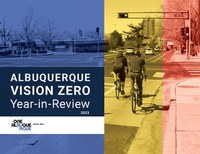
The recently City completed an update to the Vision Zero Action Plan called the Year-in-Review for 2023 (YIR). The YIR assessed progress made toward Vision Zero, including projects and programs that have been successful and also identifying which ones needed to be adjusted. The YIR ultimately prioritizes thematic goals, actions, and corridors where the City should first focus on traffic safety efforts to have the greatest impact in reducing and eliminating traffic deaths and serious injuries by 2040. It also serves as an updated Action Plan for the City to implement Vision Zero efforts. Read the Vision Zero 2023 Year-in-Review.
In May 2021, the City of Albuquerque released its Vision Zero Action, which lays out steps that the City, working with agency and community partners, will take to reduce traffic fatalities and make our streets safer. Read the 2021 Vision Zero Action Plan.
In May 2019, Mayor Keller made a commitment to Vision Zero and signed an Executive Order committing the City of Albuquerque to work toward the goal of zero traffic deaths by 2040. View the Executive Order.
The Data
Data-driven decision-making is a key element of any Vision Zero effort. In order to solve traffic safety problems in our community, we need to better understand the causes. This is some of the data that we use to help guide our work:
- View the City of Albuquerque’s Prioritized High Fatal and Injury Network (HFIN) and information about projects with traffic safety elements.
- View the Mid-Region Metropolitan Planning Organization (MRMPO) Regional HFIN
- View the New Mexico Department of Transportation (NMDOT) Vulnerable Road Users Safety Assessment
- View Safety Analysis and Regional Transportation Safety Action Plan (RTSAP) - MRMPO
- View New Mexico Traffic Crash Data from the New Mexico Department of Transportation & University of New Mexico
What We Are Doing
Unfortunately, there is no quick fix and lessons learned from other cities show that getting to zero requires long-term investment and commitment. Here are some steps we are already taking toward Vision Zero in our community.
Updates related to Vision Zero efforts are provided at the monthly Greater Albuquerque Active Transportation Committee (GAATC) meetings.
Safe Multimodal Street Design
- Complete Streets improvements: Every year, the City of Albuquerque conducts routine maintenance on 15 – 25 roadways in the city. Following guidance from the Complete Streets Ordinance (O-19-64), this program is an opportunity to improve safety and increase multi-modal transportation options by identifying locations where the road can be restriped in different ways. Improvements may include new bike lanes, new buffered bike lanes, narrower driving lanes, daylighting, or high visibility crosswalks. Learn more about 2022 Complete Streets. Learn about 2023 Complete Streets.
- Louisiana Blvd Traffic Safety Improvements
- 2020 Louisiana Blvd Road Safety Audit: With support from the Federal Highway Administration (FHWA) and the New Mexico Department of Transportation (NMDOT), the City conducted a Pedestrian Road Safety Audit (RSA) on Louisiana Boulevard from Gibson to south of Lomas to identify strategies that will increase safety and make it easier for people to walk and bike in this area. Read the report.
- Louisiana Blvd Vision Zero Improvement Project: Working toward implementing recommendations from the 2020 Road Safety Audit, this project further investigated traffic safety improvements on Louisiana Blvd from Gibson to Central. This project continued community engagement while the City worked toward identifying project implementation phases. It also further studied and designed a road diet with separated bikeways, and curb extensions, which the City expects to implement in spring 2024. Read the solutions. Read the Community Engagement Summary.
- Louisiana Blvd Vision Zero Improvement Project. Three mid-block crossings: The City received Highway Safety Improvement Program (HSIP) funding from the Federal Highway Administration (FHWA) to construct three mid-block crossings with pedestrian hybrid beacons (PHBs), also known as HAWK signals, on Louisiana Blvd between Gibson and Central. This project is currently in design with expected construction in 2025-2026. The three locations: between Eastern and Ross, between Ross and Anderson, and between Bell and Zuni.
- Neighborhood Traffic Management Program: This program implements traffic calming tools to address speeding and cut-through traffic on local residential streets.
- Automated Speed Enforcement: In May 2022, the City of Albuquerque started the Automated Speed Enforcement Program. Safe speeds are a core principle of Albuquerque’s Vision Zero approach since we know from comprehensive data that humans are less likely to survive high-speed crashes. Read the Automated Speed Enforcement FAQs.
- Downtown Safety Zone: 20 mph speed limit downtown and improvements to increase walkability and bike friendliness throughout downtown.
Shift to Active Modes
- Bike Thru Burque: This City event encourages residents to ride bicycles for transportation and explore our beautiful communities. This event is made possible by volunteers, local business support, and community advocates. It occurs annually in October and also includes riding challenges, scavenger hunts, and raffle prizes.
- Bike 2 Wherever Day: Formerly Bike to Work Day, this annual event is an opportunity to try out bicycling for transportation – it’s good for the environment, health, and it’s fun! This City would not be possible without volunteers, local business support, and community advocates. It occurs annually in May and includes riding challenges, photo contests, and raffle prizes.
Culture of Safety
- Bicycle and Trail Crossings Guide: Takes national guidance and best practices for bicycle and pedestrian crossings and adapts it to consider Albuquerque’s roadways. Helps to determine the feasibility and appropriate design for crossing treatments. The City finalized this Guide in Spring 2022, and our planners and engineers are using it in their projects. The City will also update this document as part of the Bikeway and Trail Facilities Plan Update. Learn more about the Plan Update.
- Complete Streets Ordinance: In 2019, City Council adopted an update to the City’s Complete Streets Ordinance, calling for attention to both equity and safety in roadway projects.
- School Crossings: Staff conducted a school crossing study and installed PHB/HAWK and RRFB signals at school crossings based on study recommendations, and refreshed crosswalks and signage near schools. Read the Study and view a Story Map of findings for each school.
- O-2022-038 also known as the “Pedestrian Safety Ordinance”: The City’s Vision Zero program supports any effort to make streets safer for all roadway users – especially people walking. Read the Pedestrian Safety Ordinance.
- Albuquerque Public Schools (APS) Vision Zero for Youth Initiative: This effort is currently creating a student-focused traffic safety campaign with a traffic safety curriculum, campaign materials, and community outreach. City transportation planning and engineering staff serve on the task force.
- Esperanza Bicycle Safety Education Center: Operated by the City of Albuquerque Parks and Recreation Department. They provide bicycle education, with the goal of increasing the safety, self-sufficiency, and comfort of recreational, fitness, and utility riders alike. Esperanza provides classes and programs of varied types and topics, including bicycle safety, road use and traffic law, mechanics, and riding skills.
- ABQ CiQlovía: A community-driven event that temporarily closes streets to motor vehicle traffic and allows communities to reimagine our largest public space…streets…in a whole new way.
- Balloon Fiesta Bike Valet: Our community is committed to increasing awareness about traffic safety and providing opportunities for walking and biking.
Data and Transparency
- DMD, APD, and MRCOG have recurring fatal crash review meetings.
- A data-driven approach is used throughout Vision Zero efforts. Learn more about the High Fatal and Injury Network prioritization and transportation projects that include traffic safety components, which support Vision Zero.
What You Can Do
Getting to zero requires a commitment from all of us to be careful and watch out for one another when we are on the road. Here’s how you can help:
- Take the Albuquerque Safe Streets Pledge.
- Respect all other road users - we are all going somewhere, and we all have the right to get there safely.
- Slow down - slower speeds save lives!
- Eliminate distractions - focus on the road and look for other people using the road.
- Stop at red signal lights and stop signs - make a complete stop then look for other people walking, biking, and driving before proceeding.
- Yield to people walking and biking and be extra cautious around crossings.
- Never drive when under the influence of drugs or alcohol.
Keep up-to-date with Vision Zero efforts by participating in the monthly Greater Albuquerque Active Transportation Committee (GAATC) meeting. Learn more.
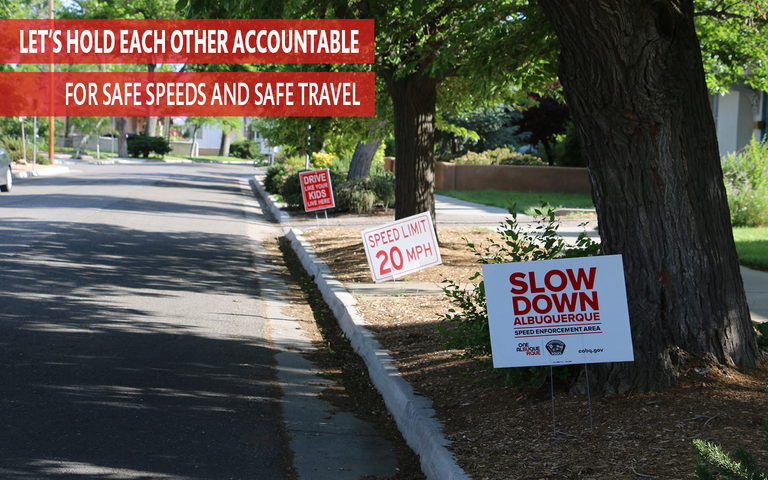
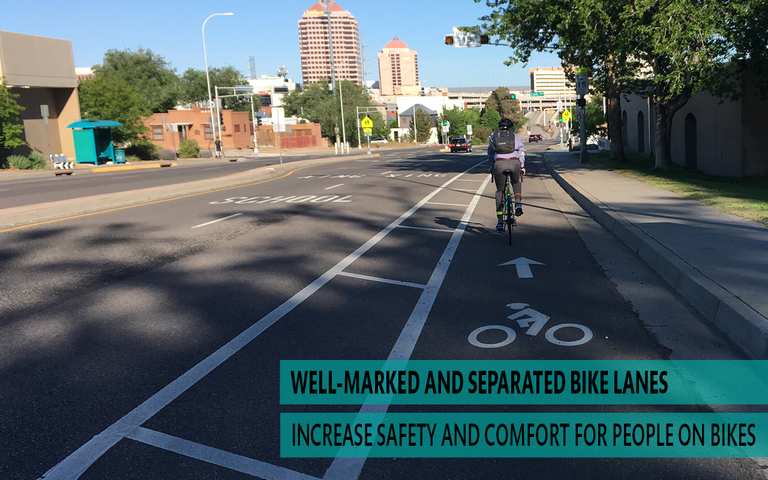
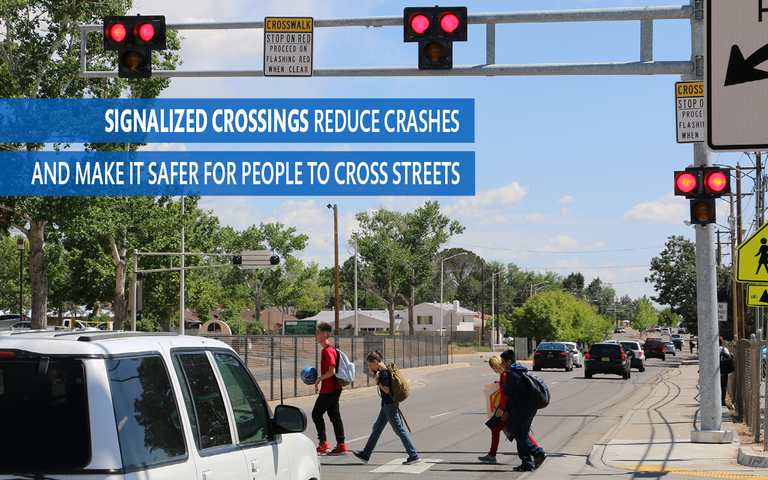
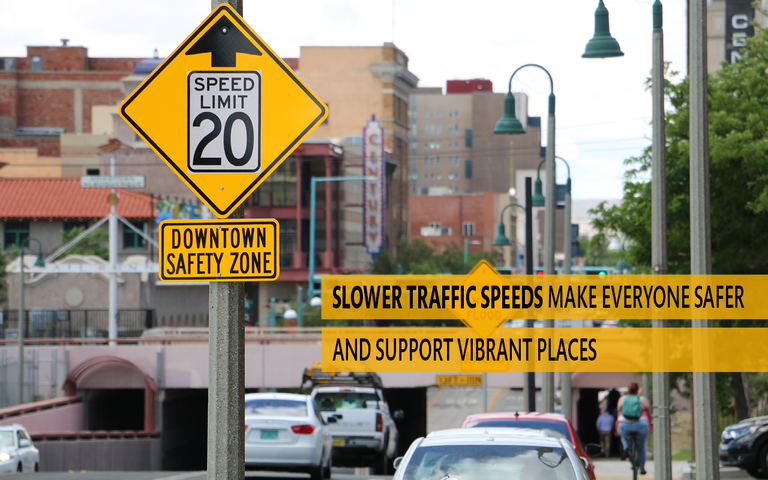
Who Is Involved?
City of Albuquerque Departments
- Mayor's Office
- City Council
- Department of Municipal Development
- Transit Department
- Albuquerque Police Department
- Parks & Recreation Department
- Planning Department
- Environmental Health Department/Sustainability Office
- Risk Management
- Office of Equity & Inclusion
- Economic Development Department
Partners
- Mid-Region Metropolitan Organization / Mid-Region Council of Governments
- NM Department of Transportation
- UNM Center for Injury Prevention Research & Education
- Albuquerque Public Schools
- Bernalillo County
- Central New Mexico Community College Sustainability Office
- Community Organizations